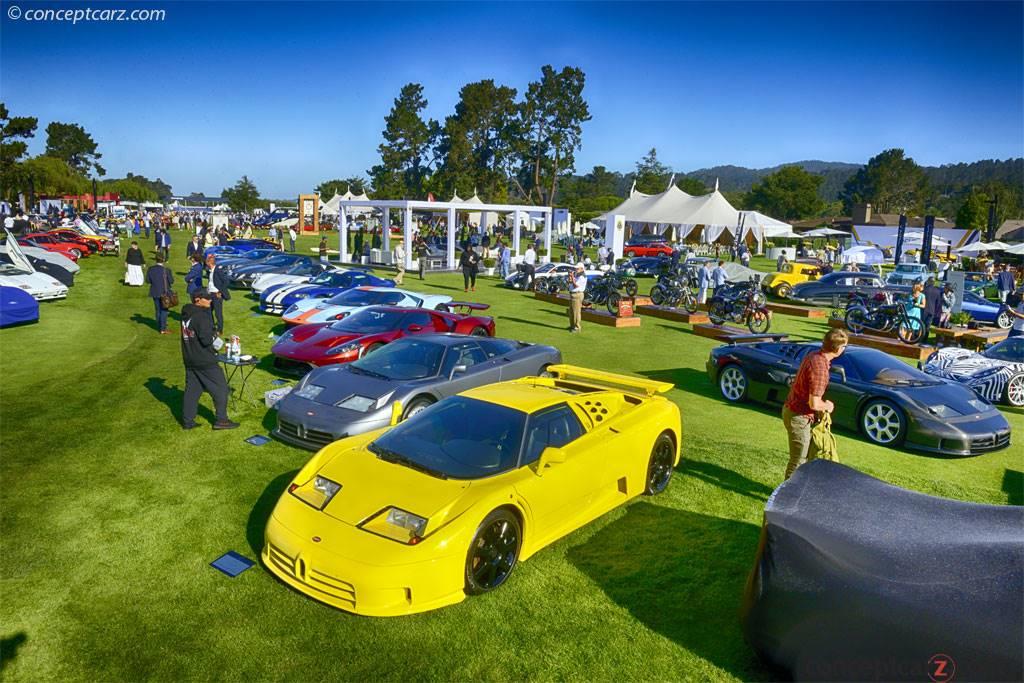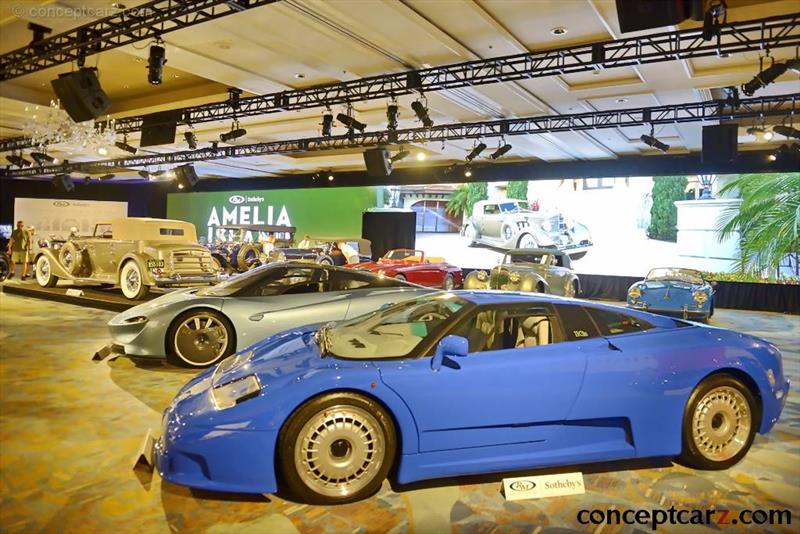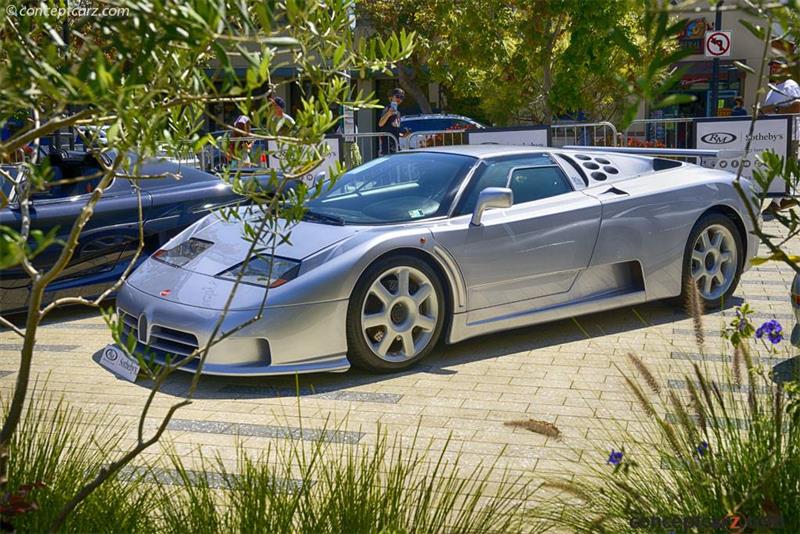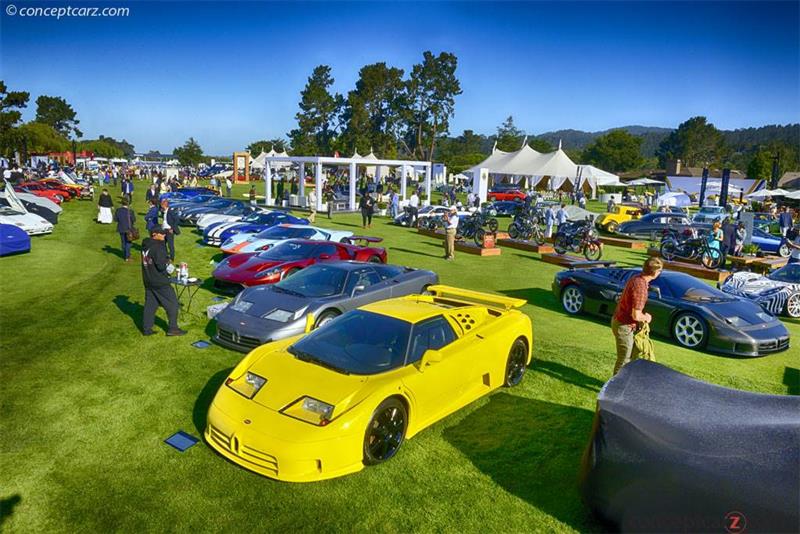The Bugatti marque remained dormant since 1952 before the storied marque was awakened by Italian Ferrari dealer Romano Artioli. The belief that it could be resurrected to its former glory was ambitious and ambitious, with his plan centered around the construction of a new supercar. Artioli established Bugatti Automobili SpA in October 1987 and broke ground on a state-of-the-art manufacturing facility the following year in Campogalliano, Italy. Artioli and his team of designers and engineers worked for four years to create a car worthy of the fabled Bugatti nameplate. On September 15, 1991, the new supercar made its debut in Paris. In celebration of Ettore Bugatti's 110th birthday that same day, the car was appropriately named the EB110.
Coupe
Chassis #: ZA9AB01EOCD39052
View info and history
Auction entries : 1The development of the engine and chassis was entrusted to Tecnostile, headed by Tiziano Benedetti, Achille Bevini, and Oliviero Pedrazzi. Chassis drawings were distributed to several designers for bodywork proposals. Among the list were Nuccio Bertone, Marcello Gandini, Paolo Martin, and Giorgetto Giugiaro. Marc Deschamps of Bertone created a design but soon lost interest in the project, and eventually, the design was used for the Bertone Lotus Emotion. The ID90 prototype proposed by Giugiaro was shown in 1990 at the Turin Car Show. Gandini had the advantage of being well known by Stanzani, the Technical Director of Tecnostile, and had created the styling for the Cizeta V16 which was powered by an engine designed by Tecnostile. Thus, early prototypes were based on Gandini's design. The designs by Marcello Gandini had graced numerous vehicles including those by Lamborghini, Lancia, Maserati, Nissan, Renault, De Tomaso, Cizeta, Alfa Romeo, Autobianchi and more. Many of his creations, including his design proposal for the new Bugatti, had angular, wedge-shaped profiles. Artioli did not agree with this design direction, nor was he impressed by the aluminum honeycomb chassis design proposed by Stanzani. Gandini created another design proposal with softer lines and numerous styling revisions but again, Artioli was not impressed. After Gandini refused to make any more changes, the design was handed over to Gianpaolo Benedini. The scissor doors and large windshield and side windows proposed by Gandini were retained, but the previous pop-up headlight design was replaced with fixed headlamps. In the front was a network of cooling ducts integrated into the front bumper section and along the sides, beyond the two large headlamps. A speed-sensitive electronic rear wing and active air flaps near the rear window were operated manually, via a switch. The Super Sport version had a fixed rear wing. Extensive testing of the aluminum honeycomb prototype chassis revealed that it lost torsional stiffness over time, resulting in degradation of handling. Artioli found this unacceptable and following requests for a redesign, prompted the departure of Gandini and Stanzani. In their wake, the role of technical director was filled by Nicola Materazzi who worked on improving the torsional stiffness. A new carbon fiber chassis was developed and supplied by Aerospatiale.Mounted mid-ship was a 3.5-liter V12 engine with five valves per cylinder (for a total of 60 valves) and four turbochargers. It had a bore and stroke of 3.19 x 2.23 inches respectively and used 12 individual throttle bodies, and delivered 553 horsepower at 8,000 RPM and 451 lb-ft of torque at 3750 RPM. Power was sent to an all-wheel-drive system which provided better handling than most other supercars of the era. Other innovative technologies used by the EB110 included the carbon fiber monocoque chassis and active aerodynamics. The transmission was a six-speed manual unit and the suspension was comprised of double wishbones. The EB 110 Super Sport was introduced in 1992 at the Geneva Motor Show, a mere six months after the unveiling of the EB 110 GT. The Super Sport variant weighed 150 kg (330 pounds) less than the EB 110 GT and was more powerful. It used carbon-fiber body panels on the interior and exterior, and the engine was tuned to produce 603 bhp at 8,250 RPM and 479 lb-ft of torque at 4,200 RPM. Between 1991 and 1995, a total of 139 examples of the EB 110 were built. The EB110 had proven to be a worthy model to wear the Bugatti name and was among the most exotic, best-handling, and fastest car of its era. Despite the car's success, the company became financially strained when Artioli purchased Lotus Cars while simultaneously developing a four-door saloon model named the EB112. Bankrupt, the company was rescued by Dauer Racing GmbH of Nuremberg, Germany and the remaining, semi-finished chassis in the assembly plant was later developed by B Engineering into their Edonis sports car which uses the monocoque chassis of the EB 110 combined with a modified version of its engine. B Engineering planned to produce 21 examples of the Edoni using parts of the original EB 110 when Bugatti S.p.A. went bankrupt.
by Daniel Vaughan | Dec 2021
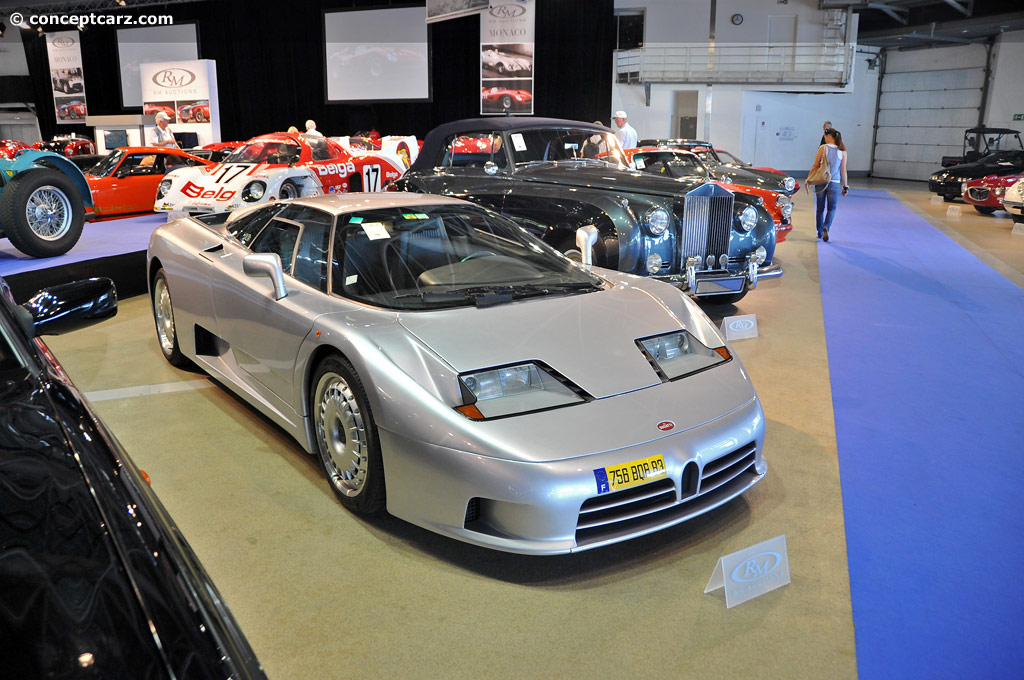
Coupe
Chassis #: ZA9AB01EOCD39052
View info and history
Auction entries : 1
by Daniel Vaughan | Dec 2021
Related Reading : Bugatti EB110 History
When Ettore Bugatti died in 1947, the Bugatti Company ceased production. The long, historic, and prestigious lineage of the famous Bugatti Company was no more. That is until 1989 when an Italian entrepreneur named Romano Artioli purchased the rights to the Bugatti name and began automobile production in an area north of Modena, Italy. To honor Ettore Bugatti, the EB 110 was created. EB was short....
Continue Reading >>
Continue Reading >>
Similar Automakers
Similarly Sized Vehicles
from 1994
1994 Bugatti EB110 Vehicle Profiles
Recent Vehicle Additions
Performance and Specification Comparison
Price Comparison
EB110 GT Specification Comparison by Year
Year
Production
Wheelbase
Engine
Prices
Related Automotive News

Concours of Elegance 2023 welcomes Bugatti – 'le pur-sang des automobiles'
Thoroughbred display of Bugattis announced for Concours of Elegance
Ettore Bugattis first-ever racing machine from dawn of motoring age
1934 Bugatti Type 59 once owned by King Leopold III of Belgium
Drop-top glamour from 1935 Bugatti Type 57 St...

Romano Artioli at 90 – a visionary and Bugatti savior
In 1952, a young 20-year-old technician in Italy watched in astonishment as Bugatti tragically ceased production in Molsheim, France. Three decades later, at the age of 59, that technician – by now a successful entrepreneur – facilitated the foundations...

Alfa Romeo Giulia Wins 25Th Edition Of 'Compasso D'Oro Adi' Award
Award ceremony for the prestigious prize, created in 1954, took place yesterday at Castello Sforzesco – Cortile della Rocchetta in Milan
During the ceremony, the public admired a Giulia Quadrifoglio and a 4C Spider Italia, two cars that express t...

ALL-NEW 2015 ALFA ROMEO 4C SPIDER PRICING ANNOUNCED
All-new 2015 Alfa Romeo 4C Spider Delivers Race-inspired Performance, Advanced Technologies, Seductive Italian Style, and Now an Even More Exhilarating Driving Experience With Open-air Freedom
All-new Alfa Romeo 4C Spiders open-air performance ****...

World-premiere: All-new 2015 Alfa Romeo 4C Spider Delivers Race-inspired Performance, Advanced Technologies, Seductive Italian Style, and now an Even More Exhilarating Driving Experience With Open-air Freedom
Production version of the all-new 2015 Alfa Romeo 4C Spider, revealed at the 2015 North American International Auto Show, will arrive at dealerships this summer All-new 2015 Alfa Romeo 4C Spiders open-air performance cockpit and mid-engine propo...
